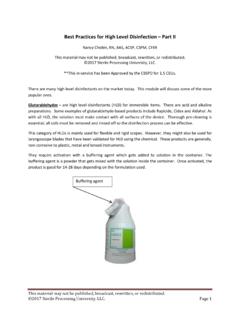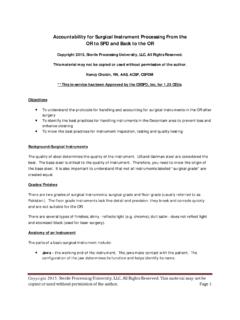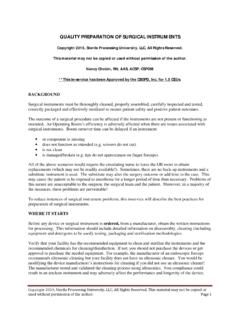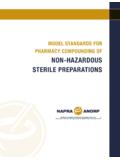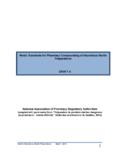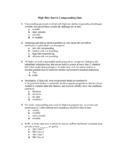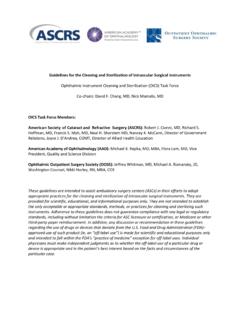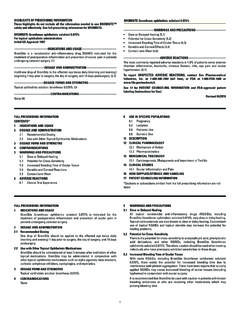Transcription of Best Practices for Processing Ophthalmic …
1 Copyright 2015, Sterile Processing University, LLC, All Rights Reserved. This material may not be copied or used without permission of the author. Page 1 best Practices for Processing Ophthalmic Instruments Copyright 2015, Sterile Processing University, LLC, All Rights Reserved. This material may not be copied or used without permission of the author. Nancy Chobin, RN, AAS, ACSP, CSPDM **This in-service has been Approved by the CBSPD, Inc. for CEUs. Objectives To identify AAMI recommended cleaning protocols To review the AAMI preparation recommendations for instruments and sets To review the recommended procedures to prevent Toxic Anterior Segment Syndrome (TASS) Background Over the past 15 years, the time to perform a cataract procedure has decreased from hours to 15-20 minutes.
2 The cost for a set of cataract instruments can range from $6,000 to $8,000 or more. Due to the short amount of time between cases, there is an urgency to turn the instruments around for the next case. Ophthalmic (eye) Instruments come in contact with the eye and thus body fluids. They are considered contaminated and must receive the entire cleaning and sterilization process between patients. Manufacturer s Instructions The surgical Instrument manufacturer should: specify the pH of detergent ( neutral pH) may recommend a pre-soak in an enzymatic cleaner to help remove protein soils ( body fluids) specify if any special cleaning implements are needed ( to clean out lumens) specify water quality for cleaning and rinsing However, as a sterile Processing professional, you need to reconcile this information with standards from the Association for the Advancement of Medical Instrumentation (AAMI), the American Society of Ophthalmic Registered Nurses (ASORN), the Association of peri-Operative Registered Nurses (AORN)
3 , Copyright 2015, Sterile Processing University, LLC, All Rights Reserved. This material may not be copied or used without permission of the author. Page 2 the American Society of Cataract and Refractive Surgeons (ASCRS) and the Centers for Disease Control (CDC). Manufacturer s Instructions are also known as Instructions for Use (IFUs). A copy should be kept on file and readily available to Processing personnel. It is important to make sure that the IFUs are followed each and every time instruments are processed. Furthermore, the IFUs should be updated every two years. Training and Competencies Employee training should complement the AAMI guidelines as well as manufacturers instructions.
4 Eye instrumentation is extremely delicate and as such requires very special handling and Processing to prevent damage. All personnel handling eye instrumentation should ensure careful handling. Employee competencies should be verified in the Processing protocols for Processing Ophthalmic instruments. These competencies should be verified initially and annually. It is recommended to use resources such as Ophthalmic instrument company's educational materials and AAMI standards for reference. Cleaning According to AAMI, cleaning is the removal of contamination from an item to the extent necessary for further Processing or for the intended use.
5 It involves the use of detergent and water for the removal of adherent visible soil ( blood, pus, protein) from the surfaces, crevices, serrations, jaws and lumens of instruments, devices and equipment, by a manual or mechanical process. Due to their design, eye instruments are challenging to clean. They can have very small lumens. Their very delicate tips can easily break or be damaged by improper handling. Decontamination OSHA defines decontamination as, the use of physical or chemical means to remove, inactivate, or destroy blood-borne pathogens on a surface or item to the point where they are no longer capable of transmitting infectious particles and the surface or item is rendered safe for handling, use, or disposal.
6 [29 CFR ]. Decontamination is generally used in health care facilities to refer to all pathogenic organisms, not just those transmitted by blood. It is the first and most critical step in breaking the chain of disease transmission. Cleaning is important because the process of disinfection or sterilization is totally dependent upon direct contact of the sterilant or disinfectant with the surface of the item. Any protein left on items can be baked on in the sterilizer. Both AAMI and AORN have a major focus on Toxic Anterior Segment Syndrome also known as TASS. This condition is an acute inflammatory response of the anterior chamber of the eye.
7 If not recognized and treated in a timely manner, TASS can lead to severe visual impairment. There are many causes of Copyright 2015, Sterile Processing University, LLC, All Rights Reserved. This material may not be copied or used without permission of the author. Page 3 TASS including detergents, water quality, steam quality, instruments, etc. The American Society of Cataract and Refractive Surgeons (ASCRS) have identified the following as major causes of TASS: Detergent residues (in general) Preservatives Residues from sterilization Processing Residues of detergents inside a reusable cannula or instrument Cement sealant on bags of irrigating solution which has leached out All of these can induce TASS and cause severe damage to ocular tissue.
8 Particular care must be taken in the Processing of intraocular surgical instruments to help ensure that foreign substances or materials associated with the instruments will not be introduced into the anterior chamber of the eye during surgery. Outbreaks of TASS have often been linked to the failure to follow the Processing procedures recommended by the instrument manufacturer. Specific instrument cleaning and sterilization recommendations intended to diminish the risk of TASS associated with intraocular surgical instruments have been published by the American Society for Cataract and Refractive Surgery (ASCRS, 2006).
9 These recommendations have also been published in AAMI ST-79 as an Annex. Some of the major recommendations include: An adequate inventory of the necessary intraocular surgical instruments should be maintained in order to allow for the timely Processing of instruments between cases. This can be a major issue in surgery centers. Insufficient inventory of instruments leads to short cuts in cleaning Adequate time must be allowed for Processing instruments according to the manufacturer s instructions; otherwise, the cleaning and sterilization of the instruments will be ineffective. A designated cleaning area and equipment specific to the cleaning of intraocular surgical instruments should be identified.
10 Whenever possible, intraocular surgical instruments should be processed separately from general surgical instruments and equipment in order to reduce the potential for cross-contamination by material or residue from the general surgical instruments Instruments should be pre-cleaned immediately following use. Gross debris should be removed, and instrument lumens should be flushed with sterile distilled water or another suitable agent as recommended in the room at the end of the procedure Only cleaning agents that have been recommended by the manufacturer should be used. Particular attention should be paid to the specified concentration of the cleaning agent and to the recommended water quality.


